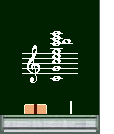Whether you play the trumpet (cornet) in a wind ensemble or brass band, it is an important part because it often plays the melody line. Whether students can play high notes seems to depend a lot on individual aptitude, but there are a few points to keep in mind during the practice process.
First, after practicing buzzing, when you first put on the instrument, start playing middle C or G

There are still teachers who call this middle C a high C, but this gives students the impression that this is the highest note.
 When I explain to students who are just starting to make sounds that the trumpet can produce a note like this without pressing the pistons, I write the notes on the board like the one on the left. Although the actual sound is different, the alto horn also produces the same sound on the sheet music.
When I explain to students who are just starting to make sounds that the trumpet can produce a note like this without pressing the pistons, I write the notes on the board like the one on the left. Although the actual sound is different, the alto horn also produces the same sound on the sheet music. I'll exaggerate a bit to get the students interested, but I've had a 3rd-glade girl who wasn't yet officially in the club in the third term play the scale up to a high C, and I've also heard a 4th-grade girl started playing the Cornet in April, and about three months later, just before the summer vacation, she played the highest G with a beautiful embouchure.
If a student can only poduce a low C
 , please have them practice buzzing again.
, please have them practice buzzing again. If students spend too much time blowing a low C with too much force and big volume, they will have a habit of tone producing with opening their lips and making sounds with the inside of their lips. This can make it difficult for some students to hit higher notes.
When considering the full range of the trumpet, it is better to think of the range from low E to the E an octave above
 as the main range.
as the main range. Therefore, if possible, practice playing high E
 before playing low C.
before playing low C. I think it will be easier to remember the good mouth shape, or embouchure, if you first learn to play the upper E and then practice the low C quietly.
In ensembles, in order to match with other instruments, it is common to start with the scale of C major (actually B-flat major), but for the trumpet, it is better to practice the scale of E-flat major

For students who can play C-G-C-E
 please have them practice the descending scale
please have them practice the descending scale with a slur before practicing pieces.
with a slur before practicing pieces. Even at this time, if the low C is played too loudly, it may be difficult to play the higher notes, so please have them play at a comfortable volume.
Practice quietly and slowly, and when they can do it, gradually speed up to the metronome
 By gradually speeding up, students seem to enjoy practicing more. With a slur, I think they can play up to about 140-160 quarter notes. Some students can play even faster tempos in a few days.
By gradually speeding up, students seem to enjoy practicing more. With a slur, I think they can play up to about 140-160 quarter notes. Some students can play even faster tempos in a few days. Even when practicing pieces, if you have new members only play the lowest parts, it will be even more difficult for them to play the higher notes. Don't limit the higher notes to the older students, but let new members experience playing higher notes if they can.
Also, instruct each student to try to play the highest note they can once a day, regardless of the piece or part.
Playing low notes carefully with a beautiful tone is difficult on a brass instrument. Stop thinking of students who can play well as higher notes.
Practicing a wider range is a common challenge for all brass instruments, but special attention is required for the trumpet.
Even if students can't play high notes on the trumpet, they can often play high enough notes on other brass instruments.
With the same breath and embouchure as playing the left note on the trumpet below, you can play the middle note on an alto, or the right note on a trombone or euphonium.

In reality, the mouthpiece and bore are different for each instrument, so the feeling will be slightly different, but please remember that the trumpet is the most difficult to play high notes.
If it has been a long time (several months) since the student started practicing and it is still difficult (painful) to play above middle C
 , it would be better for the student to try another instrument.
, it would be better for the student to try another instrument.